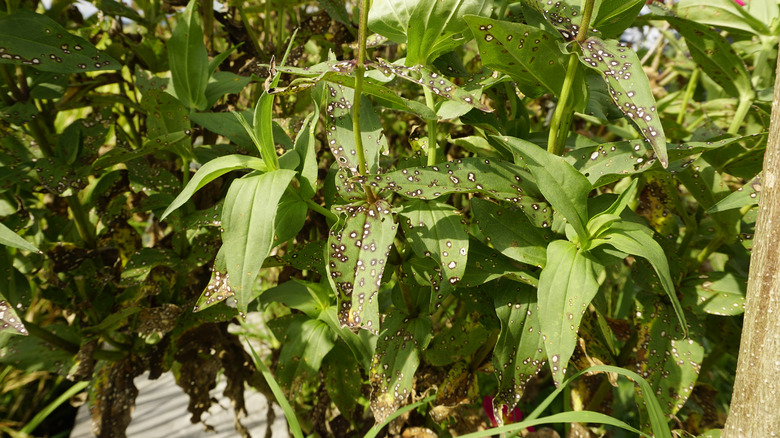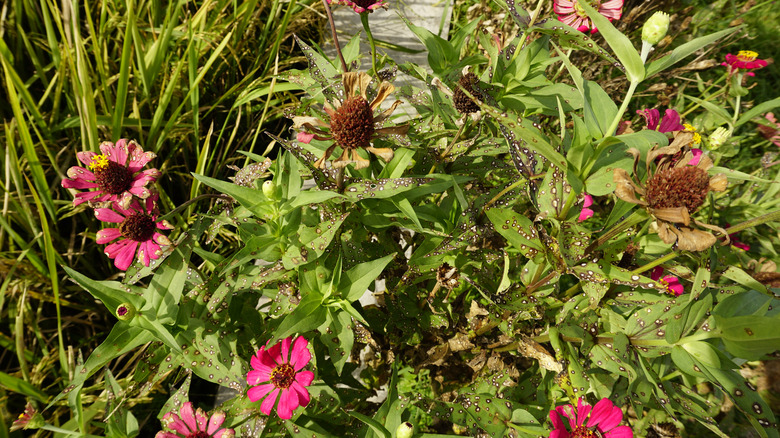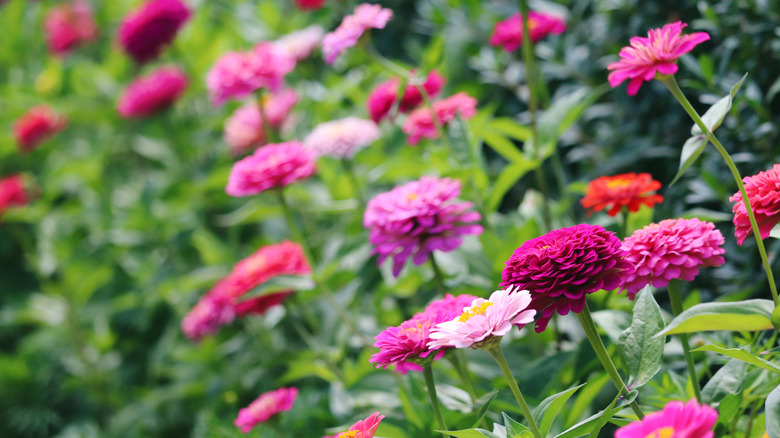What It Means If Your Zinnia Leaves Have Rust-Like Spots On Them
Growing zinnias is like lining your garden beds in rows of floral lollipops that are bursting in color rather than flavor. Because of the way the flowers bring cheer to a garden space, it's no surprise that you'll want to grow and care for zinnias in the best way you can. It can be discouraging to witness their decline when they start showing signs of problems. One disease that zinnias are susceptible to creates rust-colored spots with grayish, white centers that drastically affect zinnia foliage. This zinnia disease is called Alternaria leaf spot, and over time, it can cause zinnias to die back.
When dealing with Alternaria leaf spot, it's important to identify symptoms and know what causes the disease so you can take measures to either prevent or manage it. Preventative measures include planting resistant varieties of zinnias, rotating crops, and proper watering techniques. Additionally, you'll need to know how to manage active bouts of Alternaria leaf spot, which consists of eliminating infected debris and applying fungicides.
Identifying the symptoms and causes of alternaria leaf spot on zinnias
The disease is caused by a fungus called Alternaria zinniae. It survives in cold weather months by overwintering on seeds and in the soil. The disease spreads by spores when infected plant parts are moved around or come into contact with splashing water. Wind circulation also spreads the spores and infected seeds can even initiate the disease. When your zinnias have this Alternaria leaf spot, small, reddish brown spots appear on the surface of the leaves of the plant. Additionally, the spots will have white to grayish white centers that form on the top parts of the leaf. The older the spots, the more irregularly shaped they'll become. Then, leaves become a darker reddish brown or purple color and dry out.
Eventually, the dead tissue at the center of the rust-colored spots may fall out, resulting in a large hole. This leaves zinnia foliage desperate for repair that will never come. The spots may also form on the petioles and stems between the nodes of the plant. At the soil line, black cankers with sunken centers are common due to the rotting roots. Infected zinnias wilt and die.
How to prevent and treat Alternaria leaf spot
Fortunately, there are many preventative measures you can take to keep Alternaria leaf spot away. While no zinnia cultivars are found to be entirely resistant to Alternaria leaf spot, it can be helpful to plant varieties like Zinnia angustifolia, whichare known for fighting off disease. When planting zinnias, space your zinnias anywhere from 4 to 24 inches apart, depending on the variety. This allows air circulation to reduce humidity levels around the flowers that can become a breeding ground for the fungus to grow. Rotating the planting site of your zinnias can be helpful, as well. For home gardens, a two year rotation is enough to help prevent disease from popping up.
To treat the leaf spot, some fungicides to consider include chlorthalonil, copper fungicides, and mancozeb. You can even try using kitchen ingredients that'll destroy fungus. More specifically, your fungus saving grace may be hiding in your spice rack. On a foundational level, don't use an overhead sprinkler on your zinnias. The fungus needs a wet plant to germinate. Therefore, you can reduce the chances of spreading an active infection by watering your zinnias at their base, instead. Finally, ensure complete removal of any infected plant parts by burning them or sealing them in a bag and throwing them away. Don't compost these parts. The disease can remain on tainted debris for at least two years, so you wouldn't want any of it to linger and risk re-infecting your garden.


